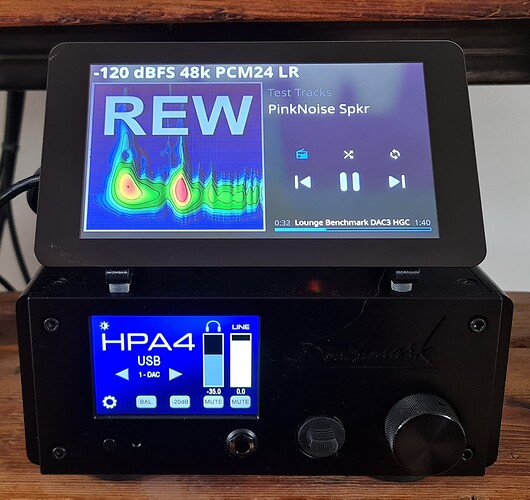OK, I’ve done the first part.
Made a -120dBFS 24bit/48kHz pink noise track in REW, converted it to FLAC, loaded it into my local library and played it in Roon.
Volume on HPA4 was at 0dB, i.e. maximum. This equates to playing both AHB2s at full volume. 380W per channel into 8 ohms.
Couldn’t hear a thing from the speakers with my ear pressed up against the drivers. No noise, no hiss, nothing, SILENCE.
Network and RPi aren’t contributing anything AUDIBLE to the noise floor of my setup, despite using an enterprise switch with its own built-in SMPS, standard Cat6 cables AND powering the RPi via PoE+. THE PoE+ HAT has its own SMPS too which offers up 3.3 V, 5 V and 12 V from the nominal ~48 V supplied from the switch.
There’s a lot of noise around here, but none of it coming from ethernet… ![]()
EDIT:
Streaming audio is just data. It’s just bits - you can’t change the “sound” of streamed audio data, because that would change the data and the TCP checksum would fail, there would be packet retransmission, potentially packet loss and gaps in playback. Jitter is a non-issue for TCP. Data is time independent and buffered and reconstructed at each interface.
So the audiophile ethernet aficionados tell us it’s not the data, it’s “NOISE” propagating via ethernet cables and polluting the analogue output of the DAC. My experiment says otherwise - there’s no audible noise propagating into the DAC from either the ethernet, or the PoE+ powered RPi because there’s nothing coming out of the DAC. And it has to be the least audiophile network setup going.
Standard Cat6 cables and patch panels, a standard enterprise grade switch, even PoE+ power to the (ca. £200) RPi end point (this also opens up questions around high-end streamers!). No fancy USB cable connecting the DAC. Interconnects between DAC/HPA4/AHB2s are as per Benchmark’s spec - Canare Starquad cable (2 of them are Van Damme Starquad cable, which makes no difference) and Neutrik XLRs, ordinary SPOFC speaker cables connected via Neutrik Speakons.
The Benchmark gear has sufficiently low THD+N to resolve Hi-Res audio, i.e. to get out of the way and let anything else be heard. In this possibly worst-case scenario, it turns out there is nothing else to be heard when it’s playing “silence” (-120dBFS test track) amplified to the maximum capability of the gear. Were I playing a 0dBFS signal at this level, my speakers would go up in smoke and the AHB2s would shut down. I’d also suffer permanent hearing damage.
EDIT 2: OK, this is a little nuts, the HPA 4 has a further 15dB of gain to offer. It can output up to 20 Vrms on the balanced analogue outputs. At about a further 4dB of gain, I could hear a faint hiss which stopped if I paused the noise track. Hmm, was I actually hearing a -120dBFS pink noise track? Only one way to find out - I made a -120dBFS 1 kHz square wave and listened to that. Sure enough, at about +4dB, I can make out a 1kHz tone. Yes, there’s a little hiss with it, but the tone is there. So I have to push a -120dBFS test track into audibility before I can make out any noise coming from any of the equipment. So even listening to music with 100dB transients, the noise is at least 20dB below the threshold of audibility. And I suspect here, I’m hitting the limits of the Benchmark DAC, line amp and power amps.
Nothing from ethernet, or from the RPi is adding anything audible.

